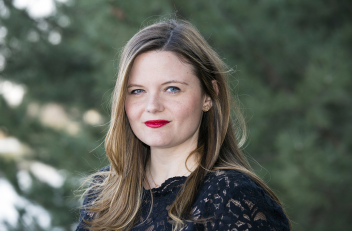Katelyn Ohashi Takes a Bow
After years of physical and emotional suffering at the elite level, the 'Perfect 10' gymnast finally found happiness—and stardom—in college. She plans to go out on top.
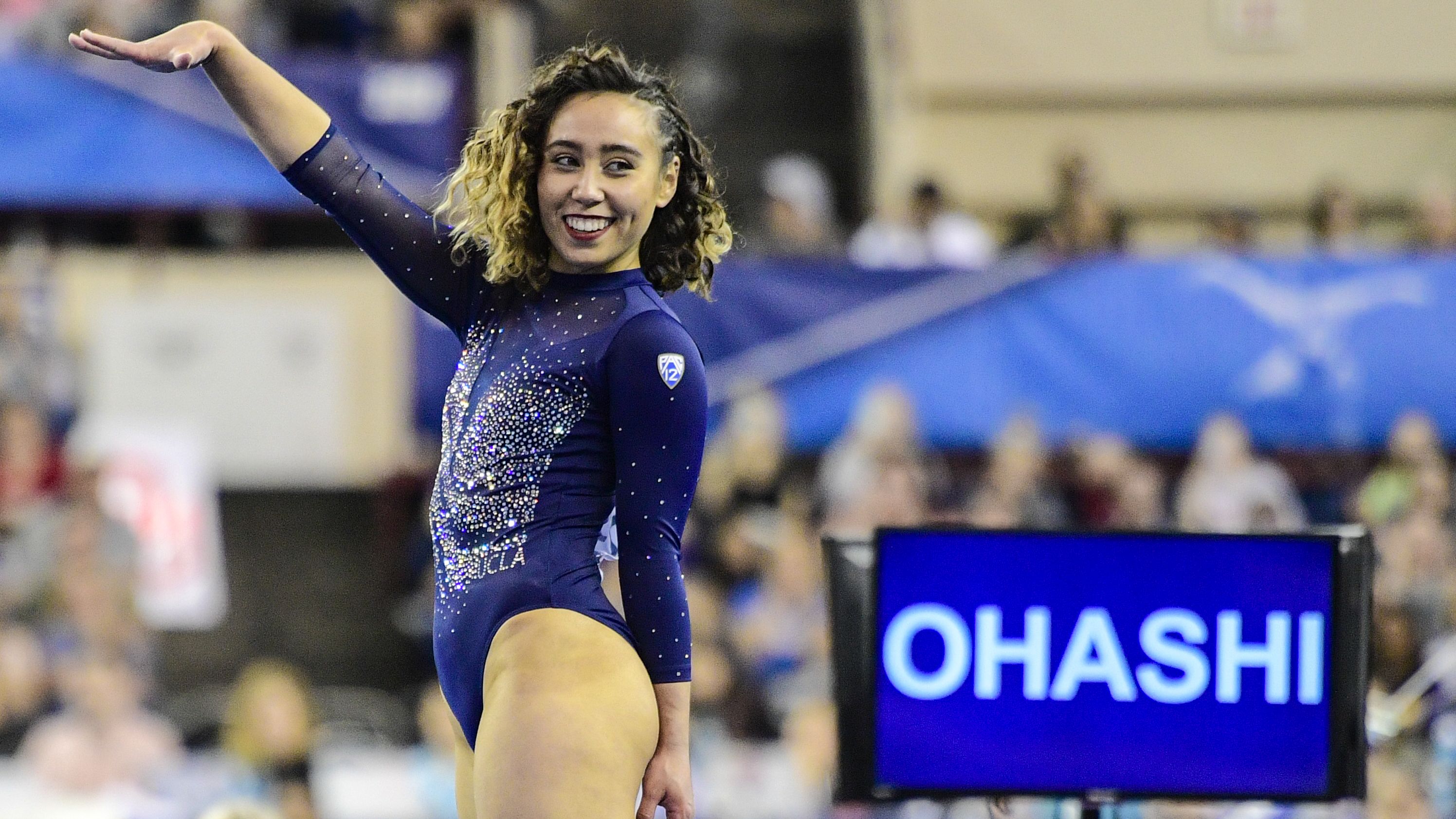

There’s a certain way someone stares at you when they think they know you from the internet. Katelyn Ohashi, the viral star of the University of California Los Angeles gymnastics team, knows the look well. “You can tell when someone recognizes you and they want to say something, but they don’t want to bother you,” she says. When they finally muster up the courage, they ask, “Oh my gosh, are you the perfect 10?” She replies, laughing, “I’m Katelyn Ohashi, nice to meet you.”
At first, she was a little puzzled by the numerical nickname. But she’s learned to embrace her celebrity—lord knows, there are far worse things to be known for online than notching the highest possible score while dancing to Beyoncé and Tina Turner. “What I have now, it’s really chill because I have honestly some of the coolest people stop me,” Ohashi says. “The most appreciative and kind.”
It makes sense that a gymnast known for the infectious joy she elicits would have nice fans. After years of turmoil for the sport, Ohashi is filling stadiums, performing some of the toughest tumbling passes in the nation, bringing much-deserved attention to the very talented athletes who compete at the collegiate level, and injecting a welcome dose of happiness to a sport that sorely needs it.
Gymnastics is still recovering from the sexual assault scandal perpetrated by Larry Nassar, who will spend the rest of his life in prison after being convicted of molesting more than 300 young women. But the issues in the sport go far beyond one bad man. Nassar’s crimes exposed a much deeper culture problem, one that prizes gold medals over the health and wellbeing of its athletes and is only now undergoing the hard and necessary work of remaking itself.
A word of advice to the people in charge: Let Ohashi be your guide. After all, she’s not only the best in the nation on the floor, having scored an incredible six perfect 10s this season for a routine watched by a whopping 117 million people and tweeted by the likes of Senator Kamala Harris and Janet Jackson—she is clearly having an absolute blast while doing it.
If you’re just tuning into the Katelyn Ohashi show, you might be saddened to learn she’s about to compete for the last time. On April 19 and 20, her team—the number two ranked, defending national champion Bruins—will compete in the 2019 NCAA National Collegiate Women's Gymnastics Championships in Fort Worth, Texas, which means it’s time for Ohashi, a college senior, to say goodbye to the sport that has defined much of her life.
Ohashi’s mom Diana likes to say that her daughter started doing gymnastics in utero. “She used to tell me I did back flips and cartwheels in her stomach,” Ohashi says. It runs in the family—Diana competed in gymnastics in college, and coached the sport recreationally at a gym in Seattle, where Ohashi was born. While her mom worked, Ohashi says she would be “just flipping around,” waiting for her shift to end.
Get exclusive access to fashion and beauty trends, hot-off-the-press celebrity news, and more.
By age 4, when most preschoolers are able to perform a wobbly cartwheel at best, Ohashi had mastered a back handspring. “You couldn’t get me out of the gym,” she says. Foreshadowing her viral fame, performing before a crowd was what she loved most. So much so that when she was 5, she was given the chance to move up to Level Four, typically reserved for 7-year-olds, but refused because doing so would have made her ineligible for competition that season. “I was like, Well, why would I move up if I can’t compete? That’s my favorite part.” Back then, she did gymnastics only for herself. “There wasn’t a lot of pressure,” she says. “I didn’t have to live up to expectations. It wasn’t ever forced upon me.”
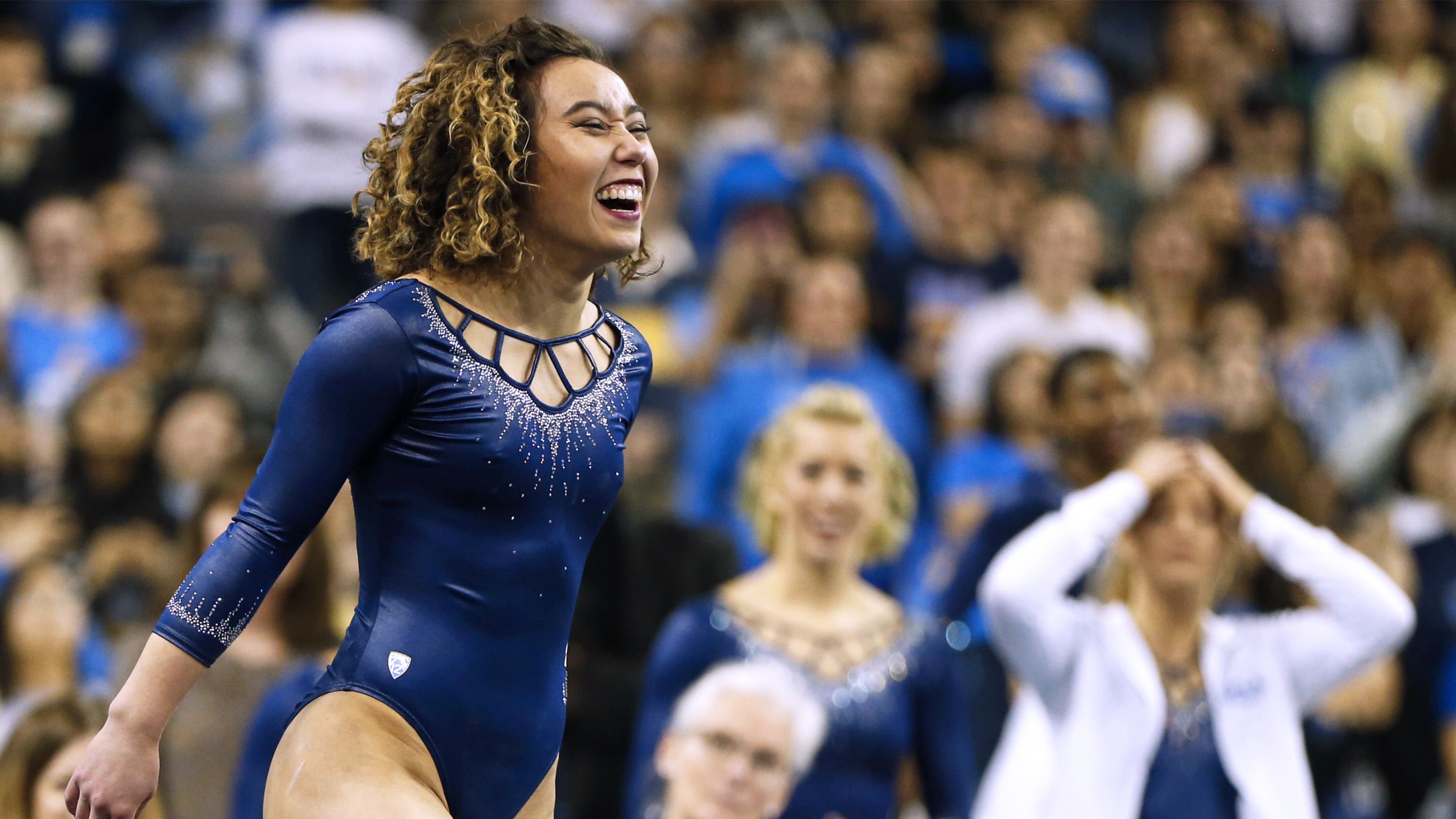
Ohashi competing during a meet against Stanford earlier this year.
That started to change in 2006 when her parents decided Ohashi, then age 9, would move with her mother and younger brother to Kansas City, Missouri, so she could train at the Great American Gymnastics Express, where several Olympians and world champions have trained. Her father, Richard, and two older brothers stayed behind in Seattle. “I knew we were moving, but it wasn’t real to me yet,” Ohashi says. “I remember waking up in the car, and I was just bawling because I was just not ready for it.” She says she was a “huge dad’s girl,” so moving away from her father was very hard. “I would find myself waking up crying,” she recalls. “I would cry myself to sleep all the time.” Her dad came for visits, but saying goodbye never got easier. “Every time he would come around it just made things harder for me,” she says. “It’s easier when you don’t see them because [every time he left], it was a whole process to go through again.”
The move placed a lot of weight on her young shoulders. “My parents made this huge sacrifice—they moved across the country, put their marriage on hold for me. When I think about it, I’m like, Wow, parents would do anything for you. And my parents are everything—they’re so amazing and it’s just crazy that they were willing to do that,” Ohashi says. “But as a 9-year-old person who feels like they are splitting their parents apart, there was a lot of pressure for me to live up to the expectations that my parents and family had for me.” She felt bad for her brothers in Seattle, “like, ‘Oh, mom just left us all behind for our little sister,’” Ohashi says. But they never gave her a hard time. “I’m so grateful that they have never ever taken anything out on me.”
In 2009, when she was 12, Ohashi made the U.S. Junior National Team along with Aly Raisman, Jordyn Wieber, and Kyla Ross—all of whom would go on to be members of the gold medal-winning “Fierce Five” squad at the 2012 Summer Olympics in London (Ohashi missed the Olympics age cutoff by four months). After she made the team, her family moved again, this time to Plano, Texas, so she could train at the World Olympic Gymnastics Academy under Valeri Liukin, a former gymnast who won four medals for the Soviet Union at the 1988 Summer Olympics in Seoul and who would go on to lead the U.S. women's national gymnastics team from 2016 to 2018.
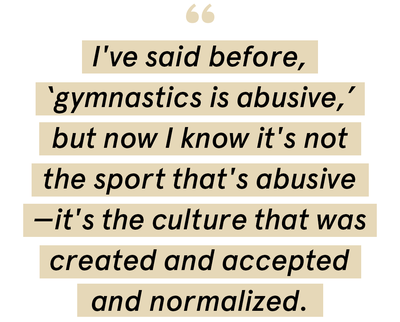
In Texas, Ohashi’s gymnastics career kicked into high gear. She began training twice a day for a total of seven hours, six days a week. Her grueling schedule meant she had to be homeschooled. “My whole social life changed,” Ohashi says. “Everything revolved around gymnastics.”
Asked if she feels like she had a childhood, Ohashi immediately says no. “People would ask me, ‘Oh have you seen this movie?’ and I’m like, No, I didn’t have that portion of my life almost,” she says. “But I had a lot of other opportunities that other people didn’t. I got to travel to Italy three times. I got to go to South Africa. I couldn’t be more grateful for stuff like that.”
Her coaches began talking about the Olympics as an inevitability. “The Olympics were something that was put in my path,” she says. “I knew I was capable, I worked so hard for it, so I guess it’s like, Why wouldn’t I want to go to the Olympics? But it was never something that I was really, really dead set on. It was just what my coaches and everyone else forced upon me.”
When she was about 14, the demands led to disordered eating. “My friends and I started getting really self-conscious,” Ohashi says. “We would hear stuff from our coaches. I was told I looked like I swallowed an elephant or a pig, that my face was the size of a balloon.” She and her friends came up with games she now describes as “sick” to see who could eat the fewest amount of calories per day (ideally fewer than 500, she says). “We would measure our thighs and if we couldn’t fit our hands around our mid-thighs, then we’d stop eating for the rest of the day,” Ohashi says. “Whenever we’d go to a party where there was a lot of food, we’d feel so bad about eating that we would go to the bathroom and throw up without realizing that’s an eating disorder.”
Her mom hid the Pop-Tarts and candy she’d purchased for Ohashi’s brother from her; if Ohashi found the stash or bought junk food for herself, she’d feel “so, so sick and guilty that I would go into my bedroom and jump rope and do other conditioning until I felt good enough to go to sleep,” she says. Ohashi sometimes got kicked out of practice on Mondays after “gaining half-a-pound over the weekend,” she says. “Or if I couldn’t make a skill, my coach would ask my mom, ‘What is she eating?’”
In 2013, she was 15 and at the height of her elite career. She beat Simone Biles, now the most decorated gymnast of all time, to win the American Cup. It should have been one of the happiest moments of her life, but she was in too much pain to celebrate. Reviewing videos of herself at the competition, she says, “You can literally see the pain on my face. Any time I watch it, I’m like, Wow, I tried so hard to conceal it, but I was hurting so bad.” She remembers running her hand across her spine, wondering if it was normal to have so much pain. “I couldn’t do even the slightest things. Even my back touching the floor was excruciating,” Ohashi says. “I felt like no one even cared to understand what I was going through. My coach knew my back hurt, but that was the extent of it.” She wishes she could tell her younger self to “put yourself first and always love what you do,” she says. “Gymnastics is not the world.”
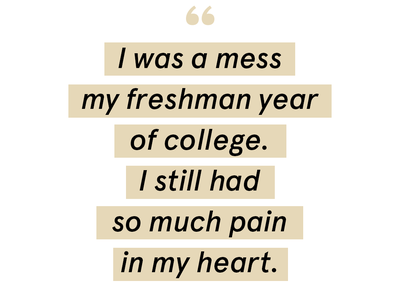
She attempted to carry on as normal after the American Cup. “I was trying to make it through practice, but every turn I took I would be in tears,” she says. “Finally, I was like, ‘Mom, I have to schedule an MRI.’” When the results came back, she learned she’d been competing with a fractured back and two torn shoulders. The doctors told her she needed surgery and that she “might never do gymnastics again,” she recalls. Larry Nassar, then the national medical coordinator for USA Gymnastics, advised against surgery so that she could continue competing. “Larry Nassar said I'd be worse off if I got the surgery,” Ohashi says. “He told us to go against [the doctor’s recommendation] and to try rehab.”
She refused, opting to have surgery and was in a brace for about four months before starting physical therapy. “They put the medals before our bodies,” Ohashi says. “America was doing great in the Olympics every single time, so what we went through was never questioned or even really looked into. We just all stayed silent. We all complied. It was like we didn't even see anything wrong with it.”
Many people might have walked away from the sport forever, but after a year off, Ohashi missed it. “I’ve always had an undeniable love for gymnastics,” she says. Elite gymnastics was no longer an option—her body couldn’t handle the training demands—but she’d heard great things from fellow gymnasts about Valorie Kondos Field, known affectionately as “Miss Val,” the head coach of the UCLA Bruins gymnastics team, and decided to give her a call. Ohashi didn’t even know if she wanted to do gymnastics again, but after talking to Miss Val, she decided to visit campus. “I ended up really, really loving the team, so my new goal was to get back into the gym so I could compete for UCLA.”

Ohashi says the goal for her routines this year was “honestly just to improve everything—how do we become more joyful?”
She switched coaches and started training again, competing at Level 10—the highest level before elite—during her senior year of high school. (After her injury, she returned to public school, graduating in 2015.) “The process of getting back into the gym was humbling. I’d probably gained 30 pounds, I went through puberty, I had to relearn the simplest of skills,” she says. “But I felt like this time it was on my terms. Everything that I did, I wanted to do. If I didn't like it, I felt like I could always say, ‘I don't want to do it anymore,’ and it would have been okay.”
When she arrived at UCLA for her freshman year, she still had a lot of work to do. Not just on her skills, but on herself. “I was a mess my freshman year of college. I still had so much pain in my heart,” she says. “I was rebelling a lot—partying, drinking, overeating, taking out my anger from my past coaches out on my present ones.” She couldn’t understand when people gave her praise. “I used to hate when my coaches would say, ‘Good job,’ to me. I was not used to that and it made me super uncomfortable because I'd never heard that in my entire life. I felt there was some ulterior motive behind it.”
She started seeing a psychologist and a nutritionist, eventually working her way back to having a healthy relationship with the sport. “I've said before, ‘gymnastics is abusive,’ but now I know it's not the sport that's abusive—it's the culture that was created and accepted and normalized,” she says. College gymnastics has an entirely different vibe. “It’s not about the gold medal—we’re not trying to go to the Olympics—we know this is it for us. After these four years, gymnastics is over,” Ohashi says. Miss Val’s coaching strategy, which Ohashi says places the person before the athlete, meant there was far less pressure on her to put the sport before everything else. “You can clearly see a difference between us and other teams,” she says. “You can still get results without abuse.”
And Ohashi has gotten results. Her junior year, she scored three perfect 10s for a floor routine set to Michael Jackson songs. Her performance, complete with moonwalking, made her the co-national champion on the floor, helping the Bruins win the 2018 national title (they beat University of Oklahoma by just 0.0375 points). It also gave Ohashi her first taste of fame, with the routine racking up more than 90 million views. But the virality made little impact on her life: “There wasn’t much that changed—it happened and then it was over,” she says. “You know when people say you get 15 minutes of fame? That’s really how it was last year. I got a decent amount of new followers, but nothing compared to this year.”
She wanted to outdo herself this year, but creating an online frenzy wasn’t the target. “It’s hit or miss with the internet,” Ohashi says. “So the goal with this year’s routine was honestly just to improve everything—how do we become more joyful? How do we be more intricate with dance?” She earned her first perfect 10 for the routine at the Collegiate Challenge on January 12. When she stepped on to the floor, she felt the world was primed for her performance. “Last year, my routine went viral in post-season—this year, it was the second meet of the season,” she says. “I feel like people may have been waiting for it.”
UCLA tweeted the routine later that night, writing “a 10 isn’t enough for this floor routine.” Ohashi says she was on date at an ice skating rink the next day, trying to ignore her phone, which was constantly buzzing with notifications. “I’m like, What is going on?” she says. “When I got home, I looked at my phone and was like, Oh shoot, I have 50,000 more Twitter followers than earlier today.” She also gained more than 600,000 new followers on Instagram; friends sent screenshots of famous people who had shared the performance. “I was in shock,” she says. “I had to stay off social media for a couple of days because my phone was giving me anxiety.” She asked her friend Simone Biles for advice. “She was like, ‘It’s fine, just don’t pay attention to it. You can still get on social media, just only look at what you want to look at,’” Ohashi says.
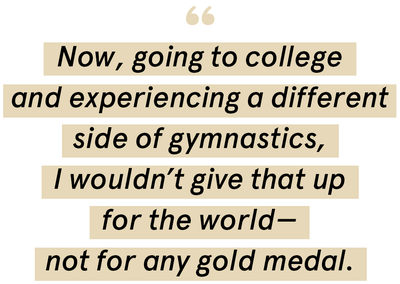
You might think Ohashi would be bummed that her notoriety has come just as her gymnastics career is ending, but for her, this is exactly the right time. “People are just starting to realize who I am, and they’re like, ‘Oh no, it can’t be over yet—you’re kidding me!’” she says. “But I never would have wished for this to happen any earlier because I wouldn’t have been ready for it. I have grown so, so much and stepped into who I want to be in the future.”
Who she wants to be is someone who uses her fame to spur discussions and action around issues she’s passionate about: body image, mental health, domestic violence, homelessness. “I’ve been waiting for my platform to get to this point,” says the gender studies major, who blogs and writes poetry with a friend on a website they created together called Behind the Madness. “I’ve always been sharing this stuff—I just have a lot more ears now.” And the fact that it’s happening right when she’s graduating has “opened tons of thousands of doors,” she says. She’s gunning to go on Dancing With the Stars, and wants to publish a book of her poetry. “I will miss gymnastics, but mostly I feel really, really good about it ending,” she says. “If I had another year, there’s no way I’d take it.”

Ohashi celebrates winning the 2018 Division I Women's Gymnastics Championship with teammate Christine Peng-Peng Lee.
Still, people can’t resist asking her if she’s headed to the Olympics next year. “For some reason, people only watch gymnastics when it’s the Olympics, so that’s the first thing every gymnast is asked,” Ohashi says. “I think it’s absurd when I get that question, especially now when I’ve been on both sides and am so much happier in college. The amount of success I’ve had is amazing—I don’t need the Olympics to validate that I’m a good gymnast.” Even though it was a bumpy road to get to this point, she says she wouldn’t change a thing. “I could have ended on the highest note of my life after winning the American Cup. That was a solid way to go out, but I would have hated the sport after,” she says. “Now, going to college and experiencing a different side of gymnastics, I wouldn’t give that up for the world—not for any gold medal.”
Ohashi sees being an “open book” about what’s she been through as her final contribution to the sport. “It’s my way of giving back,” she says. “I’ve come full circle: I was unhappy, and now I love gymnastics again. I share my story so that other people will hopefully not have to go through that.” One chapter of that story is ending, but she couldn’t be more excited for everything to come. Regardless of what happens at nationals, the gymnast who won the world over with her dance moves, is hoping you’ll still be watching as she tries to impress again—this time, with her voice.
For more stories like this, including celebrity news, beauty and fashion advice, savvy political commentary, and fascinating features, sign up for the Marie Claire newsletter.
Kayla Webley Adler is the Deputy Editor of ELLE magazine. She edits cover stories, profiles, and narrative features on politics, culture, crime, and social trends. Previously, she worked as the Features Director at Marie Claire magazine and as a Staff Writer at TIME magazine.
